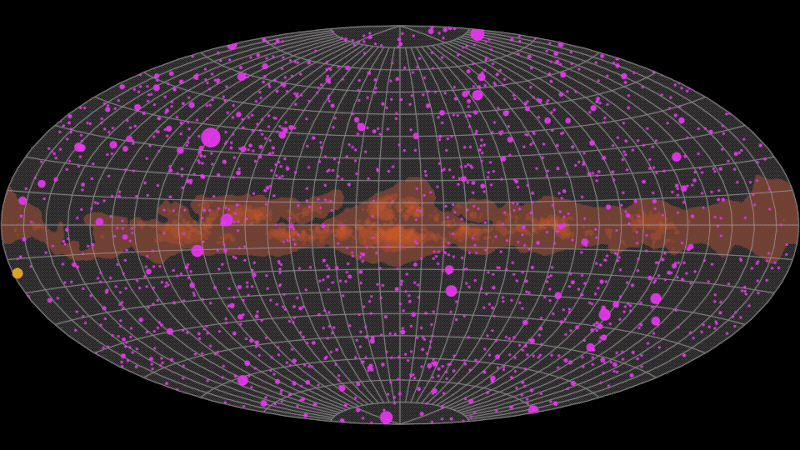A new animation allows us to get the gist of how sparkly the night sky would look to us in gamma rays thanks to the data collected by NASA’s Fermi Space Telescope in just one year.
The visible light that humans can see with our unaided eye is but a small slither of the electromagnetic spectrum. There is so much more light in the universe, and it is nice that we have built incredible telescopes to see those other wavelengths.
There are more than 1,500 light curves in the animation, with every frame representing three days of observations. The pulsation of the sources depends on the changes in their light curve, getting bigger when they get brighter. The animation is just a tease of the full data library that is now publicly available to be perused.

The animated subset of data from Fermi’s Large Area Telescope. Image Credit: NASA’s Marshall Space Flight Center/Daniel Kocevski
“We were inspired to put this database together by astronomers who study galaxies and wanted to compare visible and gamma-ray light curves over long time scales,” said Daniel Kocevski, a repository co-author and an astrophysicist at NASA’s Marshall Space Flight Center in Huntsville, Alabama, in a statement. “We were getting requests to process one object at a time. Now the scientific community has access to all the analyzed data for the whole catalog.”
Across the image, in orange, there is the plane of the Milky Way, and the yellow disk moving across is none other than the Sun, in its apparent yearly motion across the sky.
The team estimates that 90 percent of the sources in the animation are galaxies known as blazars. These cosmic islands have at their core an active supermassive black hole – and we are looking straight at it, right down the barrel of the gun. These black holes are shooting at us. Jets of material erupt from these objects moving at almost the speed of light, and Fermi can see the gamma rays from these events – but also spotted a particle.
“In 2018, astronomers announced a candidate joint detection of gamma rays and a high-energy particle called a neutrino from a blazar for the first time, thanks to Fermi LAT and IceCube,” added co-author Michela Negro, an astrophysicist at the University of Maryland, Baltimore County, and NASA’s Goddard Space Flight Center in Greenbelt, Maryland. “Having the historical light curve database could lead to new multimessenger insights into past events.”
The dataset is not just for very cool animations, but exciting astronomical observations too.
A paper about the repository was published a few days ago in The Astrophysical Journal Supplement Series.
Source Link: Animation Shows The Most Powerful Cosmic Events If They Were Visible To Our Eyes